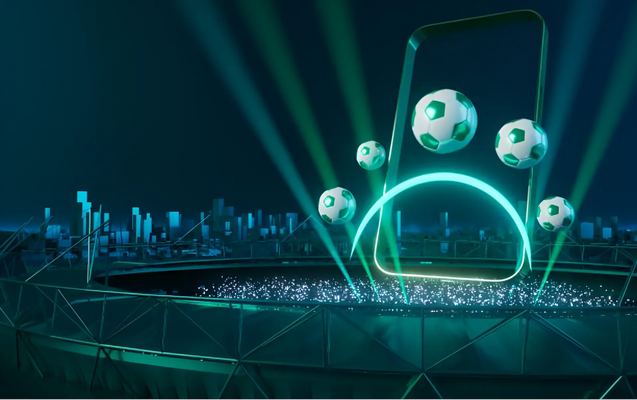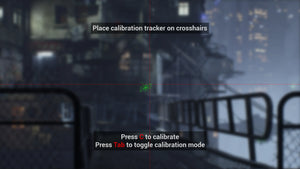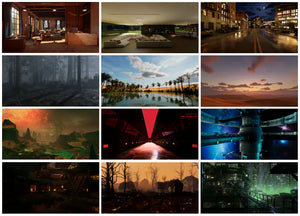VR and AR in Football: How Virtual Technologies Are Changing the Game

Football has always been a sport of passion, precision, and innovation. But in today’s digital era, that innovation is accelerating beyond anything we’ve seen before. From the pitch to the boardroom and the stands, technology is reshaping every element of the game — and at the center of this transformation lie Virtual Reality (VR) and Augmented Reality (AR).
Once considered futuristic tools for gamers and tech enthusiasts, VR and AR have now found a natural home in the world’s most popular sport. They’re revolutionizing player training, redefining fan engagement, enhancing referee accuracy, and even transforming stadium design.
As platforms like ARwall continue to pioneer immersive digital experiences, football is stepping into a hybrid realm — a new era where physical and virtual realities merge seamlessly.
This post explores how VR, AR, and other cutting-edge technologies are changing football — from grassroots development to global competitions.
1. Understanding VR, AR, and Mixed Reality in Football
Before diving into their applications, it’s crucial to understand what these technologies actually mean in the context of football.
Virtual Reality (VR)
VR transports players or fans into a fully digital environment, allowing them to experience match-like scenarios in 360 degrees. Using headsets like the Meta Quest or HTC Vive, users can simulate training drills, practice penalty kicks, or even watch games as if seated in a packed stadium — all from the comfort of their homes.
For footballers, this technology means the ability to repeat match situations infinitely without physical fatigue. For fans, it means the thrill of attending games virtually from anywhere in the world.
Augmented Reality (AR)
AR overlays digital visuals — like player stats, shot trajectories, or tactical graphics — onto the real-world environment. In football, this means fans can point their smartphones at a live pitch or screen and see interactive layers of data in real time.
Broadcasters such as Sky Sports have already integrated AR to display on-screen graphics, performance data, and even tactical diagrams, enhancing the match viewing experience with instant insights.
Mixed Reality (MR)
Mixed Reality blends both physical and digital environments, allowing virtual objects to interact with real-world elements. Imagine a coach analyzing a 3D tactical model hovering above the pitch during halftime, or a player training with holographic opponents that respond dynamically to their movements. That’s MR in action — and it’s becoming increasingly accessible as hardware improves.
The Phygital Shift in Sports
Football is becoming phygital — a fusion of physical play and digital experience. As Topend Sports notes, this merging is already evident in smart balls, AI analytics, and data-driven systems integrated across the sport.
For organizations like ARwall, which specialize in blending digital and real environments, the possibilities for storytelling, branding, and fan immersion are endless.

2. Technological Foundations in Modern Football
Even before the rise of VR and AR, football had already embraced digital transformation through core technologies designed to improve fairness, accuracy, and entertainment. Let’s explore how these systems laid the groundwork for today’s immersive innovations.
2.1 Goal-Line Technology (GLT)
One of the earliest major technological breakthroughs in football was Goal-Line Technology (GLT) — officially introduced in the 2014 FIFA World Cup.
This system uses a network of high-speed cameras and magnetic sensors to detect when the ball has completely crossed the goal line. Within seconds, the referee receives a signal confirming a goal.
Popular GLT systems like Hawk-Eye and GoalControl revolutionized officiating by eliminating human error from one of the most controversial aspects of the game.
The success of GLT opened the door for integrating more advanced real-time technologies — a precursor to immersive, data-driven decision-making systems now used in football.
2.2 Video Assistant Referee (VAR)
Building upon GLT, the Video Assistant Referee (VAR) system was introduced to review critical match decisions, including goals, penalties, and red cards.
Through multiple high-definition camera angles and instant replay, VAR allows off-field officials to assist referees in correcting “clear and obvious” mistakes.
However, VAR has also sparked debate about transparency and the viewing experience. This is where AR visualizations are stepping in — to help fans and officials see precisely how and why a decision was made, using AR overlays and 3D reconstructions that improve trust in the system.
As AR capabilities evolve, future VAR decisions could be shown to audiences in augmented 3D visualizations, allowing fans to see exact player positions, offside lines, and ball trajectories in real time.
2.3 Semi-Automated Offside Technology (SAOT)
A recent innovation showcased at the 2022 FIFA World Cup, Semi-Automated Offside Technology (SAOT), uses 12 tracking cameras and a sensor inside the ball to determine player positioning and ball movement 50 times per second.
This system enables lightning-fast offside calls, reducing delays and increasing precision.
When combined with AR visualization, fans could soon see these offside lines projected on their own devices or stadium glasses — a real-time AR view of what the referees see on their monitors.
2.4 Smart Balls and Player Tracking
The ball itself has become a data-gathering device. Using in-ball sensors and magnetometers, smart balls capture precise data such as spin, speed, and impact angles. Meanwhile, players wear GPS vests and biometric trackers that measure heart rate, sprint speed, and fatigue.
This combination fuels both AR data overlays for live broadcasts and VR simulation models used in player training.
Imagine a VR environment that replicates how the ball behaves under different weather conditions or surfaces — allowing players to adapt their techniques before match day.
2.5 Broadcasting and Augmented Graphics
Modern broadcasting relies heavily on AR and data visualization to enhance storytelling. Tools like AR graphics overlays, virtual scoreboards, and heat maps turn complex statistics into accessible visuals for fans.
According to Sky Sports, AR elements will soon become even more personalized, allowing viewers to toggle data layers — from player fatigue to tactical formations — on their screens.
2.6 Stadium Infrastructure and Connectivity
The foundation for immersive AR/VR experiences also depends on smart stadium infrastructure — high-speed Wi-Fi, 5G connectivity, and IoT-enabled devices.
Next-generation stadiums like Tottenham Hotspur Stadium and Camp Nou’s upcoming renovation are being built with AR/VR integration in mind, enabling real-time content delivery, immersive advertising, and even virtual attendance experiences. Future stadiums will be designed to host hybrid audiences — physical fans in seats and virtual spectators joining through immersive VR platforms.
3. The Rise of Virtual and Augmented Reality in Football
The past decade has seen AR and VR evolve from experimental concepts to essential tools shaping how football is played, trained, and consumed. Their integration isn’t limited to one domain — it’s a full-spectrum transformation across the sport’s ecosystem.
Below, we explore the five major areas where these technologies are already making a difference.
3.1 Transforming the Fan Experience
Perhaps the most visible transformation driven by AR and VR is the redefinition of the fan experience.
Virtual Match Attendance
Imagine watching a live match from the center circle, the goalkeeper’s box, or even beside your favorite player. With VR stadium experiences, fans can now choose virtual vantage points and feel as if they’re physically inside the stadium — even from thousands of miles away.
Companies like Sky Sports envision metaverse viewing spaces where fans can gather in digital stadiums, socialize, and even customize their experience with interactive content and stats.
Augmented Reality Overlays
AR apps allow fans to use smartphones or AR glasses to access real-time player stats, goal replays, and interactive sponsorships during a live game. This transforms passive watching into an engaging, data-rich experience.
For example, pointing your phone at a player could instantly show his sprint speed, distance covered, or current stamina levels.
Interactive Advertising and Merchandising
AR opens up new commercial opportunities. Virtual billboards can display customized ads depending on who’s watching, while AR-enabled merchandise (like virtual jerseys or collectible NFTs) extends fan loyalty into the digital space.
This is where ARwall’s cinematic AR experiences can play a key role — allowing teams and brands to merge storytelling with technology.
3.2 Revolutionizing Player Training and Development
For players and coaches, VR and AR are becoming indispensable tools for skill development, tactical learning, and mental conditioning.
VR Training Simulations
Using VR, athletes can immerse themselves in realistic match environments. Goalkeepers can practice saving penalties taken by AI-generated opponents, while defenders can analyze opponent patterns before game day.
As noted by Universidad Europea, VR allows players to practice in high-pressure virtual matches, improving reaction times and cognitive decision-making without physical fatigue.
Augmented Tactical Coaching
AR can project tactical lines and formation grids directly onto the training pitch, giving players a visual understanding of positioning and spacing. Coaches can pause play, draw in virtual arrows or heat zones, and replay scenarios instantly.
Mental Resilience and Cognitive Conditioning
Beyond physical performance, VR is being used to train mental focus. Players can simulate match-day pressures — crowd noise, penalties, and time constraints — helping them maintain composure in real matches.
Injury Rehabilitation
VR-based rehabilitation programs simulate controlled match movements, helping injured players rebuild confidence and coordination safely before returning to real play. Clubs like Manchester United and PSG are already testing VR therapy tools for injury recovery.
3.3 Enhancing Refereeing and Officiating
Football’s integrity depends on fair officiating — and AR/VR technologies are now helping referees make faster, more transparent decisions.
Augmented Refereeing
AR glasses and on-field displays can overlay real-time data, such as offside lines or foul zones, directly in the referee’s field of view.
Imagine a referee wearing smart glasses that show a digital boundary line during a close offside decision — no need to rely entirely on camera angles or delayed replays.
While still in its experimental stage, such AR integration could dramatically reduce human error and controversy in football officiating.
Immersive VAR Training
Just like players, referees can now train in VR environments that replicate match-day intensity. Using real-world match data, VAR officials can practice making decisions in simulated games with crowd noise, player pressure, and complex angles.
This allows new referees to gain experience without the stakes of real matches — improving judgment, consistency, and confidence under pressure.
3D Reconstruction for Transparency
Future broadcasts may allow fans to view disputed decisions through AR-powered 3D replays, showing the exact ball trajectory and player positions. This kind of transparency could change how fans perceive refereeing, turning potential frustration into educational insight.
3.4 Revolutionizing Broadcasting and Media
AR and VR are transforming how football content is produced, delivered, and experienced — both live and on-demand.
Immersive 360° Broadcasting
Broadcasters are experimenting with multi-angle 360° cameras placed throughout the stadium, enabling fans to experience matches in virtual reality environments.
Fans could soon switch viewpoints during live matches — from pitch-level to aerial shots — or even “stand” next to players during free kicks.
AR-Enhanced Storytelling
Augmented Reality graphics are no longer just aesthetic overlays; they are narrative tools. Broadcasters like Sky Sports and BT Sport use AR visualizations to illustrate tactical formations, heatmaps, and xG (expected goals) in real time.
This turns the broadcast into an interactive learning experience — helping viewers understand complex tactics visually.
Second-Screen AR Experiences
Fans can also enhance their experience through mobile AR apps. By pointing their phones at the TV, they can unlock layered stats, live data, or mini replays that correspond with on-screen events.
This multi-device synergy deepens engagement — keeping fans immersed before, during, and after each match.

Virtual Content Production
AR and VR tools are revolutionizing production logistics. Studios can now create virtual sets that replace physical stages with digitally rendered environments — a domain where ARwall’s real-time XR production expertise is especially relevant.
Football broadcasters and clubs are increasingly using these tools for post-match analysis, interviews, and promotional content.
4. Benefits of VR and AR in Football
The integration of VR and AR technologies offers multifaceted benefits that extend to every stakeholder in the sport — from players and coaches to fans, referees, and sponsors.
4.1 For Players and Coaches
-
Accelerated Learning: VR allows players to revisit tactical drills repeatedly without fatigue or risk of injury.
-
Performance Feedback: AR visualizations during training sessions help coaches demonstrate positioning, timing, and movement in real time.
-
Data-Driven Insights: Wearables and AR systems enable immediate access to performance analytics directly overlaid on the field.
-
Injury Prevention: Virtual simulations allow medical teams to monitor biomechanical performance and reduce injury risk.
4.2 For Fans
-
Immersive Experiences: Fans can “attend” matches virtually from anywhere in the world.
-
Interactive Content: AR applications enable fans to customize what they see — from replays to stats overlays.
-
New Engagement Models: Virtual collectibles, AR-based mini-games, and metaverse fan zones deepen emotional connection.
4.3 For Referees and Officials
-
Greater Accuracy: Real-time AR overlays support more precise decisions.
-
Improved Training: VR simulations expose referees to rare and complex situations for practice.
-
Transparency: Visual 3D reconstructions can be shared with audiences, improving fairness perception.
4.4 For Clubs and Organizations
-
Brand Innovation: Implementing AR/VR strengthens a club’s modern image, attracting sponsors and global attention.
-
Revenue Generation: Virtual attendance, interactive ads, and digital merchandising open fresh income channels.
-
Sustainability: Virtual operations and remote fan experiences can reduce carbon footprints associated with physical events.
5. Challenges and Limitations
Despite the promise of immersive technologies, several barriers remain before VR and AR become mainstream in football.
5.1 High Infrastructure Costs
Building AR/VR-compatible stadiums, broadcasting networks, and training facilities requires massive investment. Smaller clubs may struggle to justify costs without measurable returns.
5.2 Hardware and Accessibility
VR headsets and AR glasses remain expensive and bulky for mass audiences. Widespread adoption depends on making these devices lightweight, affordable, and user-friendly.
5.3 Latency and Synchronization
Real-time overlays must align perfectly with live action. Even minor delays in AR visuals could mislead referees or disrupt fan immersion.
5.4 Data Privacy Concerns
Wearable sensors and biometric tracking systems collect vast amounts of personal data. Strict privacy and consent protocols are needed to protect athletes and users.
5.5 User Adaptation
Traditional fans and players may initially resist immersive systems, preferring classic experiences. Transitioning requires education, comfort, and cultural change.
5.6 Regulatory Framework
FIFA and national associations must adapt existing regulations to accommodate XR integration in officiating and fan interaction.
6. The Future of Football: A Hybrid Digital Frontier
What lies ahead for football’s technological evolution? The next decade promises an unprecedented blend of physical and virtual worlds — an evolution that ARwall and similar innovators are uniquely positioned to accelerate.
6.1 Fully Immersive Match Viewing
As 5G and cloud rendering improve, fans could experience matches in true VR, complete with dynamic camera switching and haptic vibrations matching crowd intensity.
6.2 AR Glasses for Live Stadiums
Imagine attending a match wearing lightweight AR glasses that display real-time player stats, tactical visuals, and social interactions synced with the live game.
6.3 Cognitive Analytics in Real Time
AI-powered AR will soon provide predictive metrics — such as “expected pass” or “tactical gap alerts” — displayed during live play, giving coaches unparalleled insights.
6.4 Virtual Training Academies
Football academies might run fully virtual campuses where global players join remotely for synchronized drills and match simulations using VR avatars.
6.5 Sustainable Smart Stadiums
Using AR/VR, future stadiums will simulate crowd flow, energy efficiency, and logistics before construction, leading to safer and more eco-friendly designs.
6.6 The Metaverse Football Ecosystem
Metaverse integration could enable cross-platform experiences — where fans own digital tickets, attend games virtually, trade collectibles, and interact with club communities in persistent virtual spaces.
ARwall and the Future of Immersive Football
Football is no longer just a game played on grass — it’s a dynamic, data-driven, immersive experience that transcends physical boundaries.
With AR and VR technologies, the sport is evolving into a multi-dimensional spectacle where fans, players, and brands coexist in hybrid digital spaces.
As an innovator in extended reality and immersive storytelling, ARwall is helping shape this future. From interactive fan environments to virtual set production and stadium visualizations, ARwall bridges imagination and reality — empowering clubs, broadcasters, and sponsors to redefine how the beautiful game is experienced.
Experience the Future of Sports with ARwall
Bring your stadium, broadcast, or brand experience into the next generation.
Partner with ARwall to create immersive environments, virtual match experiences, and augmented storytelling that engage audiences like never before. Book a Demo or Consultation with ARwall Today





